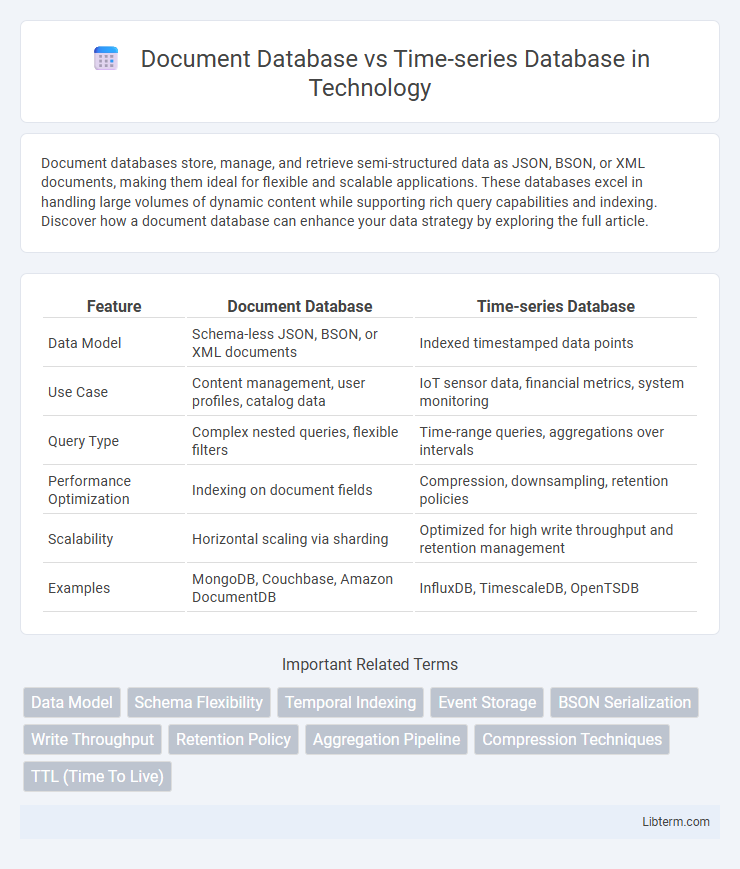Document databases store, manage, and retrieve semi-structured data as JSON, BSON, or XML documents, making them ideal for flexible and scalable applications. These databases excel in handling large volumes of dynamic content while supporting rich query capabilities and indexing. Discover how a document database can enhance your data strategy by exploring the full article.
Table of Comparison
| Feature | Document Database | Time-series Database |
|---|---|---|
| Data Model | Schema-less JSON, BSON, or XML documents | Indexed timestamped data points |
| Use Case | Content management, user profiles, catalog data | IoT sensor data, financial metrics, system monitoring |
| Query Type | Complex nested queries, flexible filters | Time-range queries, aggregations over intervals |
| Performance Optimization | Indexing on document fields | Compression, downsampling, retention policies |
| Scalability | Horizontal scaling via sharding | Optimized for high write throughput and retention management |
| Examples | MongoDB, Couchbase, Amazon DocumentDB | InfluxDB, TimescaleDB, OpenTSDB |
Introduction to Document and Time-series Databases
Document databases store data in flexible, JSON-like documents, enabling efficient handling of semi-structured or unstructured data for applications requiring dynamic schemas. Time-series databases are specialized for capturing, storing, and querying time-stamped data points, optimized for high write throughput and time-based queries in use cases like monitoring, IoT, and financial analytics. Both database types address specific needs: document databases excel in versatility and schema evolution, while time-series databases offer performance and indexing tailored to temporal data.
Core Concepts: What Defines Each Database Type
Document databases store data in flexible, schema-less JSON or BSON documents, allowing for complex, nested structures that facilitate semi-structured data management and dynamic querying. Time-series databases specialize in efficiently storing and querying time-stamped data points, optimized for sequential writes, high ingestion rates, and time-based analyses such as trends, anomalies, and forecasting. Core concepts of document databases center on document-oriented storage and indexing, while time-series databases emphasize temporal data organization, retention policies, and compression techniques tailored for time-indexed data.
Data Structure: Documents vs. Time-stamped Entries
Document databases organize data into flexible, JSON-like documents that can store complex nested structures, making them ideal for applications requiring rich, schema-less data representation. Time-series databases specialize in handling time-stamped entries, optimized for sequential data points indexed by time, enabling efficient storage, retrieval, and analysis of time-dependent information such as sensor readings or financial metrics. The fundamental difference lies in document databases emphasizing varied, hierarchical data models, while time-series databases prioritize chronological data optimized for rapid time-based queries and aggregations.
Storage Models and Indexing Approaches
Document databases store data in flexible, JSON-like documents optimized for hierarchical data representation, using indexing techniques such as inverted indexes and compound keys to support complex queries on nested fields. Time-series databases organize data as time-stamped sequences, employing optimized storage models like columnar or compression-based formats to efficiently handle high write loads and large volumes of chronological data. Indexing in time-series databases typically leverages time-partitioned indexes and bitmap indexes to accelerate time-range queries and aggregation operations.
Query Capabilities and Language Support
Document databases excel in flexible query capabilities by supporting rich JSON-based queries, indexing, and aggregation pipelines that allow complex document-level operations. Time-series databases specialize in time-based queries, providing optimized functions for range queries, downsampling, and time-window aggregations to efficiently handle chronological data. Both database types support various query languages, with document databases commonly using MongoDB Query Language (MQL) or SQL-like syntaxes, while time-series databases often rely on specialized languages such as InfluxQL or Flux for expressive time-series analysis.
Scalability and Performance Considerations
Document databases excel in scalability by efficiently handling semi-structured data with flexible schemas, allowing horizontal scaling through sharding and replication to manage diverse workloads. Time-series databases are optimized for high-write throughput and fast read queries on sequential timestamped data, providing compression and retention policies to enhance performance and storage efficiency. Both database types require careful indexing strategies: document databases benefit from secondary indexes for complex queries, while time-series databases leverage time-based partitioning to ensure rapid aggregation and real-time analytics.
Use Cases: When to Choose Document Databases
Document databases excel in applications requiring flexible schema designs, such as content management systems, user profile storage, and e-commerce catalogs where data structures vary widely. They efficiently handle semi-structured data formats like JSON or BSON, enabling rapid development and dynamic querying for diverse data types. When the primary needs involve complex querying on nested data and horizontal scalability, document databases provide an ideal solution over time-series databases, which are optimized for sequential, timestamped data analysis.
Use Cases: Ideal Scenarios for Time-series Databases
Time-series databases excel in use cases involving continuous monitoring and real-time analytics, such as IoT sensor data, financial market trends, and application performance metrics. They efficiently handle large volumes of timestamped data with high write throughput and enable rapid queries over time intervals. Unlike document databases, time-series databases optimize for time-based aggregation, anomaly detection, and forecasting in scenarios where temporal accuracy and scalability are critical.
Popular Solutions: Market-leading Technologies
MongoDB and Couchbase dominate the document database market with flexible schema design and high scalability for unstructured data storage. In the time-series database domain, InfluxDB and TimescaleDB lead by offering optimized data ingestion, compression, and real-time analytics tailored for time-stamped data. Both database types prioritize performance and scalability but target fundamentally different use cases, with document databases excelling in content management and time-series databases specializing in monitoring and IoT data analysis.
Choosing the Right Database for Your Application
Document databases excel in handling semi-structured data with flexible schemas, making them ideal for applications requiring dynamic data models and rich querying capabilities. Time-series databases are optimized for high-write loads and efficient querying of sequential data, supporting use cases like real-time analytics, monitoring, and IoT sensor data. Selecting the right database depends on factors such as data structure, query patterns, write/read frequency, and scalability requirements specific to your application's workload.
Document Database Infographic

 libterm.com
libterm.com